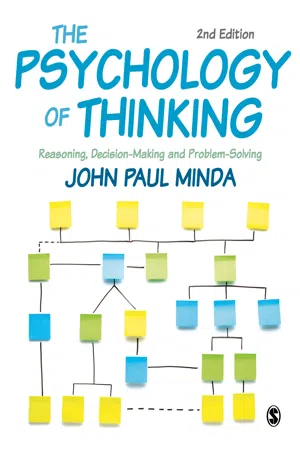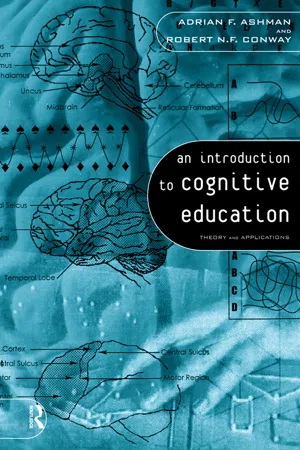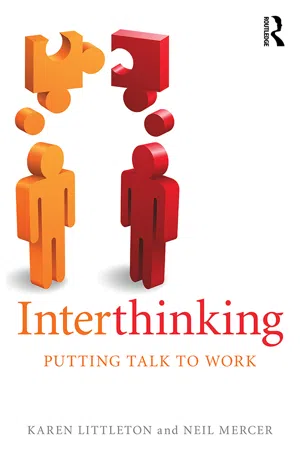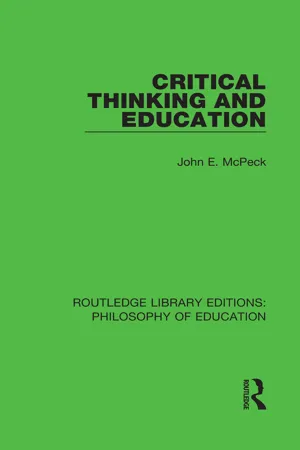Concepts of Thinking
The concepts of thinking in psychology encompass various mental processes involved in cognition, problem-solving, decision-making, and creativity. These concepts include perception, attention, memory, language, reasoning, and problem-solving. Understanding these concepts helps psychologists study and explain how individuals process information, make decisions, and solve problems in different situations.
7 Key excerpts on "Concepts of Thinking"
- eBook - ePub
The Psychology of Thinking
Reasoning, Decision-Making and Problem-Solving
- John Paul Minda(Author)
- 2020(Publication Date)
- SAGE Publications Ltd(Publisher)
...1 The Psychology of Thinking Thinking is so central to the human experience that it has been described as the essence of being. We are all familiar with the phrase, “Je pense donc je suis” or “I think therefore I am”. This comes, of course, from Descartes’ Discourse on Method (1637) and underscores what is so crucial and compelling about the study of thinking. Humans, like other animals, behave, learn, respond, communicate, and remember. But humans also think. We can discover something new by thinking about it. We can solve problems in the mind, visualize solutions, and arrive at an important decision by thinking. We can be aware of our own thoughts and aware of the consequences of our actions and behaviours. This book is about the psychology of thinking. That might sound redundant, given that psychology is often defined as the study of the mind or of mental activity. In other words, if psychology is not about thinking, what else can it be about? Psychology is a very broad field, encompassing everything from the study of neurotransmitters and basic neuroanatomy to the study of learning and memory to the understanding of mental health and the study of group behaviour. This book is concerned with the study and understanding of the thought process. Thinking is usually studied within the broader field of cognition. Cognitive psychology has traditionally been defined as the study of information processing and behaviour. This encompasses everything from basic attention and perception to memory, concepts, and thinking. As a topic within the study of cognitive psychology, the psychology of thinking is concerned with complex mental behaviours, such as problem-solving, reasoning, decision-making, and becoming an expert. A good understanding of basic cognition is very useful in understanding the psychology of thinking, but it is not necessary...
- Jessica Kuper, Jessica Kuper(Authors)
- 2015(Publication Date)
- Routledge(Publisher)
...Thinking – Cognitive Organization and Processes DOI: 10.4324/9781315677101-138 The term thinking is one of those most difficult to encapsulate in a simple definition. We learn the word long before we encounter psychological research, and our ideas about thinking are strongly influenced by commonsensical notions which may not map neatly onto the concepts which psychologists have found necessary to develop when studying cognition. We may be puzzled, for example, when psychologists argue that we are not consciously aware of much of our thinking, or that it is not really sensible to draw boundaries between thinking and perceiving, understanding and remembering. In psychology the word ‘cognition’ (from the Latin cognosco, to know) has come to be used in a wide sense, encompassing perceiving, comprehending and remembering, as well as thinking, in part because psychologists are aware of the interrelationships between all these processes. Within philosophy, from Aristotle onwards, there was a strong tradition that thought involved a chain of associations of conscious images. This view underpinned the initial founding of experimental psychology in the late nineteenth century as the scientific study of consciousness. One of the major disputes in the early 1900s followed the frequent failure of subjects at Würzburg, when introspecting on their thought processes, to report imagery. It is easy to verify for oneself that one can think of the superordinate category of ‘cat’ or an example of a flower without any intervening imagery. William James had already commented that thought was like the perches and flights of a bird (1890). During the flights, we are not aware of the components which lead to the next conclusion. Subsequently, there has been general agreement that much of the processing that underlies thinking, as well as the other cognitive processes, is not available to consciousness...
- eBook - ePub
- Johanna Turner(Author)
- 2017(Publication Date)
- Routledge(Publisher)
...[2] Thinking, problem solving and concept learning In schools teachers often claim that they are encouraged to teach children to think; their aim is to teach the structure and main concepts of a subject rather than the facts. But, in these situations, teachers may wonder what exactly it is they are being asked to do: Doesn’t everybody think? What is a concept? What is involved in problem solving? The discipline of psychology was originally primarily concerned with the study of thinking – the activity of the conscious mind. Psychologists today are particularly interested in the cognitive processes by means of which man makes sense of his environment, both material and social. Thinking, problem solving and concept learning, all of which children use in school, are three basic cognitive processes whose psychological theory is introduced in the work reviewed in this chapter. In particular, the findings of Furth and Wachs, Wertheimer, and Klausermeier and his associates, may help teachers to design lessons which will deliberately aid their pupils to develop these processes and hence be able to apply them more effectively. 1 Thinking 1.1 Ways of thinking Like ‘intelligence’, ‘thinking’ is a polymorphous term in that it can be applied to many different sorts of activity, from rigorous logical analysis to free floating daydreaming...
- eBook - ePub
An Introduction to Cognitive Education
Theory and Applications
- Adrian Ashman, Robert Conway(Authors)
- 2002(Publication Date)
- Routledge(Publisher)
...Chapter 3 Cognition and cognitive concepts Cognition refers to knowing and thinking. Hence, it involves taking in, storing, retrieving, transforming, and manipulating information that is obtained through the senses. It also involves perception, awareness, judgement, the understanding of emotions and, of course, memory and learning. Almost everything we do during our waking lives involves thinking (and perhaps while we are asleep as well!). Indeed, it is fairly difficult to identify aspects of our daily lives that involve no thinking. In this chapter we consider some of the more common concepts to be found in the literature on cognition that relate to thought, learning, remembering, and problem-solving. Think for a moment about the last time you went to a supermarket to buy provisions. It seems like a relatively simple activity, but there are literally millions of decisions made prior to and during a shopping excursion. All of these decisions are enacted by the brain and influenced by previous learning. One way of gaining an overview of the factors that contribute to a successful shopping trip – or indeed any other activity – is to use a diagram that shows the interrelationship between key elements (see Figure 3.1). Our knowledge base provides the building blocks for learning and problem-solving. We have thousands, if not hundreds of thousands, of pieces of information stored away inside our heads. There are Figure 3.1 A schematic view of the relationship between factors that affect problem-solving behaviour • facts such as the products to be found in the supermarket • knowledge of how we deal with the world around us, using an array of strategies that help us remember what provisions we need • complex routines (or plans) that relieve the cognitive burden of day-to-day activities...
- eBook - ePub
- Karen Littleton, Neil Mercer(Authors)
- 2013(Publication Date)
- Routledge(Publisher)
...5 Language and the Process of Thinking Collectively Introduction In this chapter we will consolidate what is currently known about the process of interthinking, drawing on the ideas and research findings we have discussed in previous chapters. Essentially, we aim to provide a sociocultural account of the process, of the kind we outlined in Chapter 1, which acknowledges the relationship between individual thinking and collective thinking, the cultural and social contexts in which people think collectively and the prime role that language plays in linking human minds. In the first part of the chapter, we will use the findings of educational research on classroom talk and psychological studies of the development of children’s thinking and communication skills to discuss how people learn to interthink and how individual thinking is related to collective thinking. Using the concepts we have discussed, we then offer an explanation of how and why collective thinking can be successful among people of any age, and relate that explanation to the various domains of activity we have discussed in the previous chapters. Towards the end of the chapter, we return to a topic we considered in Chapter 3, creativity as a collective achievement, and relate this to a sociocultural account of interthinking and its development. Finally, we set out some of the key concepts we have introduced, and draw some general conclusions. The development of individual and collective thinking Many educational researchers have investigated the processes of collaborative learning, through studying how children of various ages work together in groups on set tasks and assessing the outcomes. The main aim of such research has typically been to ascertain if working in groups without a teacher is a good way of helping individual students learn and improve their understanding...
- eBook - ePub
- John E. McPeck(Author)
- 2016(Publication Date)
- Routledge(Publisher)
...Chapter 3 The Prevailing View of the Concept of Critical Thinking To imagine that thinking can be broken down into its component parts which are then programmed is to misunderstand the nature of thinking. 1 There are many programmes for teaching critical thinking already extant in the schools. My purpose here is to examine the theoretical foundation upon which many of these programmes are predicated. Just a cursory glance at some of the espoused rationales reveals a point of view marked by a naive form of logical positivism - a view that has been largely abandoned or severely qualified by most philosophers today. For example, many analyses of the concept of critical thinking are replete with lists of skills that serve tacitly as operational definitions of the concept and with lists of pitfalls to be avoided, as though these could be exhaustively anticipated in advance. In addition, there is a not-so-subtle subscription to the verifiability criterion of meaning and the repeated employment in crucial places of the fact/value distinction, as though it were non-controversial and clearly demarcated. But perhaps the most pervasive notion underlying these analyses is what amounts to an unquestioned faith in the efficacy of science and its methods to settle every significant controversy requiring critical thought. Robert Ennis's analysis If one traces the recent origins of this sort of view, through references and explicit citations, it is clear that Robert Ennis's paper' A concept of critical thinking' has been most influential. 2 When the paper was published in 1962 there was a paucity of literature analysing the concept in such a manner that educators could directly teach, and psychologists accurately test, critical thinking...
- eBook - ePub
Integrative Psychology
A STUDY OF UNIT RESPONSE
- William M & King Marston(Author)
- 2020(Publication Date)
- Routledge(Publisher)
...It possesses the generalized legs of all the horses we have perceived, and this generalization is a combination, or integration, of many percepts. A Concept, then, is the subjective name given to the psychonic energy that occurs at those correlation centres where groups of impulses coming from other correlation centres, are integrated with each other. Neurologically the human nervous system achieves its utmost refinement and complexity in the correlation system of the cerebrum ; in addition to those simplest integrations of correlation impulses which we have called Concepts, it is possible for these conceptual integrations themselves to form further mutual integrations with each other. Thus we find generalizations based upon elements which are also generalizations but of narrower scope. The narrower scope generalizations are Concepts ; the wider generalizations built upon them are the typical components of ABSTRACT THOUGHT, although the Concepts are also, on a lower level, abstract in nature, since their bases are less complex integrations of the same general type. Subjectively, Abstract Thought may take many different forms. The abstract idea of Justice, divorced from any practical application or connection with concrete objects (percepts) and situations, is an example of this kind ; the idea of Truth is another. And of course the processes of higher mathematics exhibit numerous and high degrees of mental abstraction. Basing ourselves upon the neurology of the cerebrum, we would say that Abstract Thought is the psychonic energy arising at the psychons where integration takes place between those groups of already integrated correlation impulses which themselves constitute Concepts. There exists also a slightly different kind of relationship, still of this general type, wherein two or more groups of correlation impulses may be integrated in a third correlation centre...






